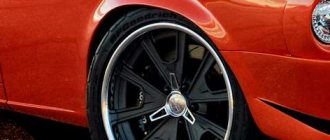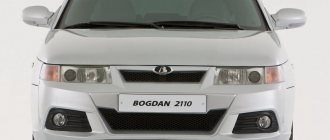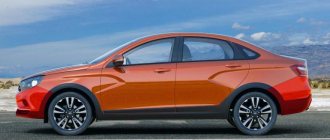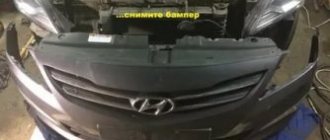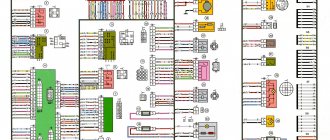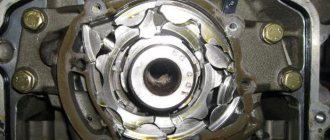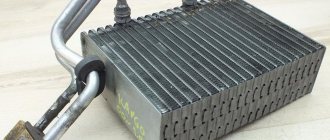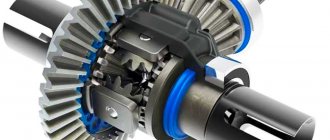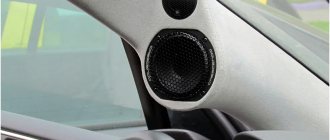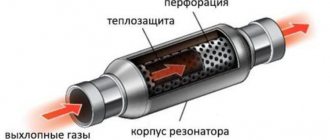Spar – a power element of a car’s design. The term spar comes from the French “longer”, which means to move along a certain direction. The spar is a supporting power element that is located along the vehicle structure. The frame or chassis always has two side members on both sides of the car - left and right.
photo gallery:
What is it, what does it look like and where is it located?
The spar in a car performs very important functions. Its design consists of pipes and jumpers installed transversely. Essentially, these are two longitudinal beams located along the entire length of the car - in front and behind the body. Externally it resembles a metal profile or box mesh. These elements also look like stairs, which is why motorists often call them “staircases.”
Special brackets are welded onto the side members. They are designed for fixing various vehicle components.
What are they for?
The parts are made of very hard metal and can withstand heavy weight. They absorb shock loads and vibrations received by the car when moving on various roads. Spars are needed to strengthen the elements of the bottom and floor of the trunk (passenger cars) or to completely take on all the loads (trucks, frame SUVs).
Another function of the side members is shock absorption. By taking on vibrations, the part distributes the load across all parts of the machine. Pipes effectively absorb deformation distortions. Therefore, they are made as rigid as possible, but not everywhere. In fact, a modern spar is a structurally very flexible unit with programmable deformation zones. Otherwise, it would not soften the shocks, absorbing them, but transmit them to the cabin.
Thus, the side members of the front part of the car are specially made with a greater ability to deform. Thanks to this, during a collision, the parts absorb the destructive shock wave, preventing it from going further.
Design Features
How did the engineers manage to come up with such a universal option?
They do this in several ways:
- reduce the thickness of the walls of the metal beam, creating a variable cross-section;
- cut through holes in areas least loaded with body weight;
- create wrinkles in the metal that allow the side members to fold during frontal or side impacts rather than break.
Another feature of the spar system is that the beams are always arranged in pairs, connected by jumpers. This forms a supporting structure or frame that provides rigidity to the body.
The spar is a channel. In the most loaded areas of the body, for example, under the engine, driver and passenger seats, its cross-section is increased, the metal is very durable. And in places where the maximum shock wave occurs during collisions, the profile is made thin and acts as a damper.
Types of spars
Spars can be composite or solid. In the first case, they look like a set of metal elements. This is a comparatively better type than the solid one, as it allows for at least some restoration. The composite spar system is divided into front, middle and rear parts.
There are also different forms of spars. For example, on heavy SUVs and trucks they are found in the shape of the letter “P”, forming a body frame. On passenger cars, the side members are not of the ladder type, since the body in this case is of a load-bearing type.
This is what they are like.
- Horizontal. The pipes lie parallel to each other. This design is typical for vehicles with increased cross-country ability.
- Curved. The beams are located along the bottom, following its contours. This design increases passive safety.
- Vertical. Due to this arrangement, a flat car floor is obtained, significantly reduced compared to traditional models.
- At an angle.
Each of these options can be found on cars, including SUVs and even trucks. However, more often on trucks the traditional horizontal design is used, in which the spars can run not only parallel, but also at an angle. The latter option makes the car more maneuverable and makes it easier to turn.
Separately, it is worth mentioning the crossbars. They act as stiffening ribs and can be placed perpendicularly, X-shaped or in the shape of the letter “K”. They are made from steel profiles and are often bent at the desired angle. In passenger cars, the cross members are secured by welding, and in trucks they are fixed with rivets.
Repair
In the vast majority of cases, repairs concern the front side members; the rear side members are deformed less often. To correct the deformation, a special caroliner stand is required. We have to disassemble a significant part of the car. But even the most experienced craftsmen are very difficult to complete the task of correcting a deformed spar. Replacement, as well as repair of the spar, is a lengthy, very complex and expensive procedure.
When the main parts of this part remain in good condition, partial replacement can be carried out using gas welding. But one should not hope that welding a damaged spar will restore it to factory quality. Its strength will decrease significantly, and accordingly, it will perform its important functions much worse. With a ladder frame, it is easier to replace the spar. But if this part is greatly damaged in the monocoque body of a passenger car, replacing the spar becomes pointless and it is often necessary to replace the entire body.
If there is a possibility of repair or replacement, it is necessary that the new part has the same dimensions as the deformed one and does not exceed them.
The spar is the most important part of the car, which remains invisible and therefore the average car owner thinks little about it. However, the condition of the car and the safety of its operation greatly depend on this detail. If you suspect that this element is deformed, you should immediately contact a car repair shop; this will help you avoid very expensive repairs in the future and increased risk while driving.
Moscow Automobile and Highway State University, Moscow. Level of education: Higher. Faculty: AT. Specialty: Special engineer Cars and automotive industry. Experience in the automotive industry (master consultant...
Advantages and disadvantages of the design
The main advantage of the spar design is light weight, flexibility and strength. The vehicle does not lose maneuverability, provides a high level of controllability, and, thanks to advanced technological solutions, also provides passive safety. If the first automobile bodies were built on the basis of a heavy and durable frame, today a frameless layout is in fashion, the basis of which is flexible side members - the real strength elements of the load-bearing body.
Unfortunately, there are also disadvantages:
- in case of accidents and collisions, the machine components mounted on the side members - the engine, gearbox, suspension - are damaged;
- difficulty of repair due to design features.
The front and rear side members are firmly attached to the body by welding. Body rigidity and the degree of resistance are initially calculated by engineers at the factory. For this reason, after some serious damage, the part changes its original properties and can no longer perform its previous functions. The problem of repair is the inability to provide the necessary parameters to the spar after deformation. The beam must be reattached to the body by welding, which is difficult to do if damaged. It is much easier to cut and install a new piece of material.
Reinforcement at the initial stage of operation will help extend the service life of the vehicle's spar structure. It is necessary to install repair patches, but only on side members that do not have areas of through corrosion!
Is it necessary to strengthen
Reinforcement of technically sound side members is required only in sports and when operating vehicles in particularly difficult conditions for which the bodies are not designed.
Sometimes reinforcement is carried out after an accident, when they are trying to avoid complex repairs with the replacement of load-bearing parts. In these cases, the geometry of the body is restored by drawing on a slipway, and since the deformed spar is no longer able to work normally in the future, external reinforcements are welded onto it.
The same technology is sometimes used to repair corrosion and fatigue cracks.
Causes and consequences of deformation
Over time, the metal, under the influence of variable loads, succumbs to the effect of fatigue - cracks form on it. After ten years, the seemingly strong structure weakens and loses its former endurance. Neither nitriding nor chemical-thermal treatment helps. When a car gets into an accident, the side members are severely deformed, simultaneously worsening the overall technical characteristics of the car. It is possible that the engine, suspension and transmission parts may be displaced. And the entire body loses its inherent strength and geometry when the spar bursts. That is why, when inspecting a car on the secondary market, a specialist first checks these parts.
It is easier to restore the frame structure. On load-bearing structures, things are much worse: here the spar acts as part of the body, and in particularly unfortunate cases, changing it is pointless or simply impossible.
Bend over time
The spar can be repaired with a slight, not sharp bend. For this, a hydraulic stretching machine or winch is used. A sharp bend with an acute angle is already a loss of the basic shape. Such an element is almost impossible to restore: it is more advisable to replace part of the pipe or the entire beam.
Buckling of a straight bar is a known problem in engineering. The rectilinear shape loses stability over time.
If the side members are bent after an accident
The parts simply become wrinkled and lose their original shape. If the spar is not bent too much, it can be straightened on a slipway or caroliner. If it bursts from an impact, there is no point in repairing it. The only option left is overcooking, partial or complete. The old part is cut off with a grinder, then a new piece of pipe is installed. Anti-corrosion treatment of parts and painting are required.
Along with the side members, after an accident, such parts of the body as door connectors and fenders suffer, the position of the suspension and engine changes, the shape of the suspension is disrupted, and cracks form on the outer part of the body.
Crack or complete break
Small cracks and minor damage can be repaired. A welding machine will help in this case. It is necessary to carefully weld the cracks if the parts are not aluminum or titanium: such spars are difficult to weld.
A complete spar rupture is bad. The entire body structure suffers, especially the load-bearing type. More often than others, the front side members of the car are damaged beyond repair.
The consequences of deformation or destruction of the spar are extremely negative for the car. Incorrect camber and increased tire wear, increased play between body parts, and decreased body safety are just a few examples of a sad outcome. At high speeds, weak body rigidity can lead to loss of control, injury and loss of life.
Spars are checked correctly only on a stand. However, there are several ways to do this without equipment. If the doors or trunk lid do not lock well, or the wheels have improper camber/toeing, visually inspect the parts. The presence of cracks and pockets of corrosion is a reason to urgently seek help from a car service!
Possible faults
For the manufacture of spars, only special aluminum or titanium alloys are used. The strength of the structure is very important, since the elements are subject to constant loads.
Over time, such exposure can lead to their deformation. During operation, microcracks may appear on the metal. This effect is often called metal fatigue. Damage, bends and cracks can affect changes in body geometry and many other parameters of the car. For example, the wheel alignment angles will change, an incorrect gap will appear when closing the doors, various kinds of squeaks in the cabin, and so on.
Also, these important elements can be deformed during an accident. These are the most common cases. Bending of the side members threatens serious repairs, or even complete disposal of the body. Cracks and gaps appear, and the geometry of the body is disrupted. In this case, it is unsafe to operate the car. Even repairs do not always give the desired result. Due to geometry violations, tire wear will most likely increase and the factory steering settings will be disrupted.
Deformation zone of side members
On the other hand, side members also belong to passive safety elements. They have zones of programmed deformation. In the event of an accident, the part will bend exactly in this place, taking away part of the impact energy.
